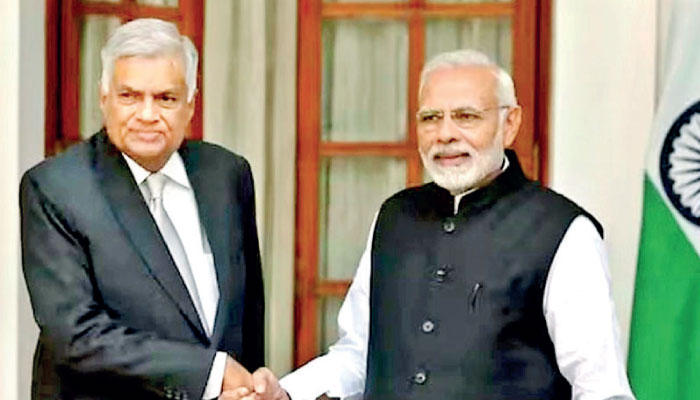Thursday Apr 24, 2025
Thursday Apr 24, 2025
Friday, 11 August 2023 01:16 - - {{hitsCtrl.values.hits}}

Unlike GR, RW did not have to make any embarrassing promise about the 13th Amendment
|
 If Gotabaya Rajapaksa’s (GR) visit to Delhi in 2020 is best remembered for his broken promise to Prime Minister Modi regarding implementation of the controversial 13th Amendment, Ranil Wickremesinghe’s (RW) in 2023 would be remembered for Modi’s promise to “strengthen the maritime, air, energy and people-to-people connectivity”, which included the construction of a land bridge across Palk Strait. This announcement and its implications could be viewed as part of India’s “neighbourhood first policy” or what Modi called in 2020 as India’s “civilisational duty” towards Sri Lanka.
If Gotabaya Rajapaksa’s (GR) visit to Delhi in 2020 is best remembered for his broken promise to Prime Minister Modi regarding implementation of the controversial 13th Amendment, Ranil Wickremesinghe’s (RW) in 2023 would be remembered for Modi’s promise to “strengthen the maritime, air, energy and people-to-people connectivity”, which included the construction of a land bridge across Palk Strait. This announcement and its implications could be viewed as part of India’s “neighbourhood first policy” or what Modi called in 2020 as India’s “civilisational duty” towards Sri Lanka.
Unlike GR, RW did not have to make any embarrassing promise about the 13th Amendment, because he was shrewd enough to initiate a dialogue on the subject with the relevant parties before flying to Delhi. But Modi’s thoughts on connectivity endorsed by RW would send jitters within the circle of diehard Sinhala Buddhist nationalists (SBN). The idea of this epochal connectivity is destined to rekindle the historic fear among the Sinhalese that India’s Tamil south and Sri Lanka’s Tamil north would be joined physically to pose a mortal threat to their dream of transforming this island into a one and only Sinhala Buddhist country in the world. It is in that dream that political Buddhism was born, a civil war was fought and current developments are stamped.
From the time of recorded history, and in spite of close economic, cultural and security contacts between India and Sri Lanka the insularity of the island was never interfered with. But Modi’s connectivity plan may change that. After that legendary Rama’s bridge, built thousands of years ago with rock and limestone to invade Lanka by Rama’s mighty army with Hanuman’s monkey brigade, to recover Rama’s abducted wife Sita, defeat Ravana in the battle field, install his brother Vibishana as dummy star, and then set ablaze the island, it was Narendra Modi when visited Sri Lanka in 2017 revived that legend and expressed his wish to build a bridge.
This time he did not quote Ramayana but the 20th century Tamil poet Bharathi who dreamt of a bridge between India and the “Sinhala Island”. The fact that Bharathi called Lanka “Sinhala-island” to the disappointment of Tamils is significant. RW’s visit to Delhi has given a new lease of life to Rama’s legend and Bharathi’s dream. India would welcome the land connectivity as part of an extension of Akand Bharat or Greater India.
But from the point of view of SBN the land bridge would open a floodgate particularly to South Indian Tamil influx under various pretensions. With an already concentrated central highlands with a community of naturalised Indian Tamils, the proposed bridge would be looked upon as a devilish scheme to jeopardise the plan to create a Sinhala Buddhist nation. There may be a possibility in the distant future for such a connectivity once the demographic topography of north and east transformed to reflect Sinhala Buddhist supremacy. The ongoing controversy and sporadic violence over Buddhist archaeological excavations, land acquisitions and construction of viharas in the north and east are part of this transformation project. This is why RW is not going to get the consensus he needs to implement the 13th Amendment.
But whether the land bridge materialises or not Indian penetration into Sri Lanka is set to speed up during the remaining months or year of RW’s presidency. If Foreign Minister Ali Sabry were to be believed, there seems to be a possibility, although denied by CBSL sources, that Indian rupee would become legal tender in Sri Lanka. RW’s every move is drawing Sri Lanka into the Indian economic and geopolitical orbit although he maintains that his regime is adopting a neutral foreign policy. But the fact that China is getting marginalised is noticeable. Even on the issue of debt restructuring India, Japan and the Paris club are acting in unison expecting China to join in if it wants to. It would be interesting to watch how China is going to react to these manoeuvres when RW is scheduled to visit Beijing for talks with President Xi Jinping. China has its own backers within the ruling coalition and they are yet to react to RW’s Indian connectivity program. When RW signed the lease over Hambantota to China, India was naturally disappointed. But now he is trying to more than compensate for that disappointment.
Given these developments, Tamils and their political parties are not willing to compromise on power devolution although they may quarrel among themselves on the modus operandi. And behind their hard stand is the continuing pressure and support from the Tamil diaspora community, which is financially resourceful, diplomatically influential and politically uncompromising. That community is playing a role similar to what the Jewish diaspora did after World War II. This was why GR promised to meet Tamil diaspora representatives for talks when he met the UN Secretary General in New York in 2021.
However, like the promise GR made to Modi, this too was not honoured. But behind the scene diplomacy of Tamil organisations abroad is making a difference on the world stage in relation to Sri Lanka’s Tamil and human rights issues. There is increasing confidence among the diaspora community that they could help build the north and east of the island economically and technologically, and make it a first-class tourist destination, once the 13th Amendment is fully implemented. SBN is aware of this potential and RW’s land connectivity project would make it more than a certainty. Hence the dissension over connectivity.
Is there an alternative route for Sri Lanka to protect its sovereignty while building the economy and uniting the nation with constitutionally guaranteed democratic rights and freedom for all its citizens? None of the parties in the opposition except NPP seems to have any counter strategy. Their policies, if there are any, looks like a dog’s breakfast. This is because none of them except the NPP want to think outside the box and change the ruling system founded on ethnonationalism, nepotism and corruption. These parties only differ in their labels but all of them are beneficiaries of the system and are committed to protect it. That was why the Aragalaya youth raised the cry for system change.
With this system in operation there is no alternative to the RW-IMF economic plan and India’s multipronged target to convert Sri Lanka into its junior partner. Modi’s connectivity agenda and his promise to exploit a bankrupt economy is actually a trap for captivity. It seems to be the Hindutva strategy to entrench India’s regional imperialism. This is why, the next election in Sri Lanka, whatever form it takes, be it local government, provincial, general or presidential, is going to determine the country’s destiny. Only NPP can make a difference, but will it cross the line?
(The writer is attached to Murdoch Business School, Murdoch University, Western Australia.)
Discover Kapruka, the leading online shopping platform in Sri Lanka, where you can conveniently send Gifts and Flowers to your loved ones for any event including Valentine ’s Day. Explore a wide range of popular Shopping Categories on Kapruka, including Toys, Groceries, Electronics, Birthday Cakes, Fruits, Chocolates, Flower Bouquets, Clothing, Watches, Lingerie, Gift Sets and Jewellery. Also if you’re interested in selling with Kapruka, Partner Central by Kapruka is the best solution to start with. Moreover, through Kapruka Global Shop, you can also enjoy the convenience of purchasing products from renowned platforms like Amazon and eBay and have them delivered to Sri Lanka.
Discover Kapruka, the leading online shopping platform in Sri Lanka, where you can conveniently send Gifts and Flowers to your loved ones for any event including Valentine ’s Day. Explore a wide range of popular Shopping Categories on Kapruka, including Toys, Groceries, Electronics, Birthday Cakes, Fruits, Chocolates, Flower Bouquets, Clothing, Watches, Lingerie, Gift Sets and Jewellery. Also if you’re interested in selling with Kapruka, Partner Central by Kapruka is the best solution to start with. Moreover, through Kapruka Global Shop, you can also enjoy the convenience of purchasing products from renowned platforms like Amazon and eBay and have them delivered to Sri Lanka.